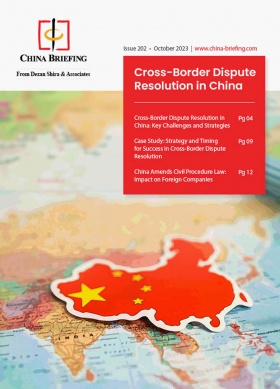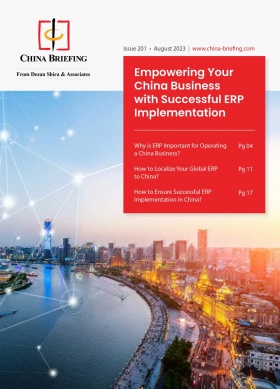Understanding China’s New-Type Industrialization: An Explainer
We discuss why China’s new-type industrialization thrust is an opportune time for foreign businesses and investors looking to expand their presence in the Chinese market. Foreign companies and IP-holders can capitalize on evolving market trends associated with the growing prominence of the industrial internet, industrial software, and industrial automation sectors as China aims to lead in frontier sectors and achieve technology self-sufficiency.
China’s ‘new-type industrialization’ (新型工业化) initiative is a comprehensive strategy to facilitate the country’s continuous industrial advancement and achieve technological self-sufficiency. The concept serves as a key component of China’s broader economic development agenda—promoting cutting-edge technologies and sustainable industrial growth. By focusing on advanced manufacturing, secure supply chains, and the development of core technologies, new-type industrialization intends to act as a catalyst for further bolstering China’s global competitiveness and positioning the country as a leading player in frontier sectors and high-tech industrial value chains. In this article, we discuss what constitutes new-type industrialization and key policy goals within the broader context of China’s industrial development goals.
What is China’s new-type industrialization?
China first introduced the concept of new-type industrialization in 2002 during the 16th National Party Congress. It represents the country’s strategic adoption of a modern industrial system that integrates knowledge, digitalization, global market participation, and ecological sustainability. The concept has thus become a cornerstone for China’s economic development and global competitiveness.
It’s also recently gained momentum, attracting heightened attention and concrete commitment from the government. In September 2023, China’s President Xi Jinping stressed the “vital role of high-quality development in advancing new-type industrialization,” emphasizing the need to adapt and lead the ongoing scientific and technological revolution. In particular, President Xi highlighted the integration of manufacturing prowess with digital economic development and industrial informatization as a critical step toward achieving national rejuvenation and building a stronger nation. Such directives were also echoed by Chinese Premier Li Qiang, who emphasized the necessity of reinforcing industrial and supply chain resilience and promoting industrial innovation capacity, alongside the integration of digital technology and green development practices within the industrial sector.What are China’s policy goals under new-type industrialization?
The key objectives of China’s new-type industrialization strategy are outlined as follows:
- Customized modernization:Within the framework of new-type industrialization, China aims to achieve industrial growth and modernization tailored to its unique context. This involves embracing technological advancements and integrating the digital and real economies to enhance production capabilities.
- Global competitiveness: A central focus is placed on strengthening China’s technological independence and reinforcing its industrial supply chains. These measures are seen as essential for establishing a leading position in the global industrial landscape, thereby enhancing the country’s overall competitiveness.
- Economic growth: Acknowledging the pivotal role of the industry as the primary driver of economic development, Chinese policymakers are prioritizing technological innovation. By placing this at the forefront of their strategy, they aim to bolster economic growth and sustain China’s position as a key player in the global economy.
How is China promoting new-type industrialization?
Since the 20th National Party Congress, new-type industrialization has gained prominence in various Chinese provinces and cities. From October 2022 to the present, the Ministry of Industry and Information Technology, as well as provinces and cities—including Shandong, Sichuan, Guangdong, Zhejiang, Shanghai, and Jiangsu—have developed multiple action plans and guidelines, as shown in the table below.
| Recent Policies and Action Plans Targeting New Industrial Development in China | ||
| Time | Plan/Policy | Details |
| October, 2022 | 20th Party Congress Report
《二十大报告》 Available here |
The 20th Party Congress highlighted the need to “build a modern economic system, form a new development pattern, and basically realize new industrialization, informatization, urbanization, and agricultural modernization.” |
| March, 2023 | Press Conference held by the State Council on Promoting the New Industrialization to Bolster the Real Economy
《加快推进新型工业化 做强做优做大实体经济》 Available here |
Details of the press conference include the following key objectives:
|
| April, 2023 | Chengdu Modern Urban Industrial Development Action Plan
《成都现代都市工业发展行动计划》 Available here |
The plan aims to foster the development of Chengdu‘s modern urban industrial sector, promoting its distinct specialization and systematic integration. It also emphasizes the support for advanced manufacturing and the synergy between productive service industries, all while strengthening Chengdu’s position as a modern international metropolitan hub with global influence. |
| May, 2023 | Three-Year Action Plan for Promoting the High-Quality Development of the Manufacturing Industry in Shanghai (2023-2025)
《上海市推动制造业高质量发展三年行动计划(2023-2025年)》 Available here |
The plan involves (among others) the following key actions for the development of new-type industry in Shanghai:
|
| September, 2023 | Action Plan for Promoting High-Quality Development of Chongqing’s Manufacturing Industry in the New Era (2023-2027)
《深入推进新时代新征程新重庆制造业高质量发展行动方案(2023—2027年) Available here |
The plan sets ambitious goals for Chongqing‘s manufacturing sector by 2027, emphasizing increased revenue, enhanced innovation, optimized industrial structure, green and low-carbon initiatives, improved spatial layout, and the promotion of enterprise upgrades. The objectives include significant financial targets, technological advancements, and sustainability measures to position Chongqing as a leading hub for advanced manufacturing in China. |
Latest trends in China’s industrial sector
In recent months, China’s industrial landscape has undergone a noteworthy upswing marked by consistent expansion and an accelerated pace of industrial upgrading. Notably, the month of August witnessed a significant surge in China’s value-added industrial output, surpassing earlier projections and foreign media expectations. The year-on-year increase of 4.5 percent in August outperformed the previous month’s 3.7 percent, highlighting the sector’s resilience and dynamism.
Concurrently, there has been a remarkable influx of investments, both domestic and foreign, specifically targeted towards advanced manufacturing and emerging industries. In the first half of 2023, foreign investment in China’s high-tech sector experienced a notable 7.9-percent year-on-year growth, indicative of the increasing confidence in China’s technological capabilities and potential. Even more striking was the 28.8-percent year-on-year surge in foreign investment in high-tech manufacturing. Expert insights also suggest that China’s current drive towards industrialization is motivated by the need to fortify the nation’s supply chains and minimize dependency on external resources. In line with this, prioritizing the development of frontier sectors within the scope of new-type industrialization remains a paramount objective.What are the opportunities for foreign investors within China’s new-type industrialization framework?
The emergence of China’s new type of industrialization presents a host of promising opportunities for foreign businesses and investors. This includes areas aligned with science and technology innovation, industrial digitalization, green transformation, as well system automation and technology upgrades. Foreign enterprises operating in these sectors, particularly those aligned with China’s policy priorities, stand to benefit significantly from this phase of industrialization.
An illustrative example is the industrial software segment, expected to play a pivotal role in steering digital transformation within enterprises. This segment is sector-agnostic and is poised to advance the new industrialization paradigm. As China’s policy environment becomes increasingly favorable, there is anticipation of substantial prospects in the development of domestic industrial software, providing a foothold for foreign companies in the Chinese market. Industry experts highlight that foreign enterprises can capitalize on evolving market trends associated with the growing prominence of the industrial internet, industrial software, and industrial automation sectors.
Companies such as SAI Information, Dongfang Guoxin, and UFIDA Networks are projected to lead the industrial internet sector, offering a potential avenue for foreign businesses to explore strategic, intellectual property, or investor partnerships. In the industrial software domain, entities like Kingdee International and Digiwin Software present opportunities for collaboration or market entry. Furthermore, companies like Weihong Software and Zhongkong Technology in the industrial automation segment are poised to provide foreign investors with a chance to tap into China’s burgeoning industrial automation sector.
In summary, robust support from the Chinese government in this domain, coupled with the country’s renewed commitment to fostering a business-friendly environment, positions the new-type industrialization thrust as an opportune time for foreign businesses and investors looking to expand their presence in the Chinese market.
About Us China Briefing is written and produced by Dezan Shira & Associates. The practice assists foreign investors into China and has done so since 1992 through offices in Beijing, Tianjin, Dalian, Qingdao, Shanghai, Hangzhou, Ningbo, Suzhou, Guangzhou, Dongguan, Zhongshan, Shenzhen, and Hong Kong. Please contact the firm for assistance in China at china@dezshira.com. Dezan Shira & Associates has offices in Vietnam, Indonesia, Singapore, United States, Germany, Italy, India, Dubai (UAE), and Russia, in addition to our trade research facilities along the Belt & Road Initiative. We also have partner firms assisting foreign investors in The Philippines, Malaysia, Thailand, Bangladesh.
- Previous Article China, Japan, South Korea Hope to Restart Trilateral Summit, Possibly Next Year
- Next Article Traveling to China After Reopening – What’s Changed?








